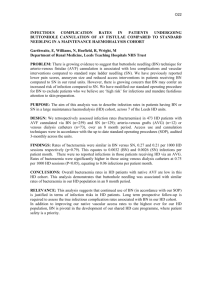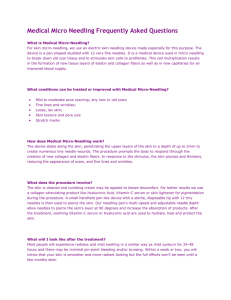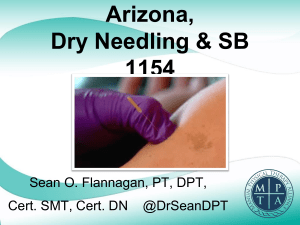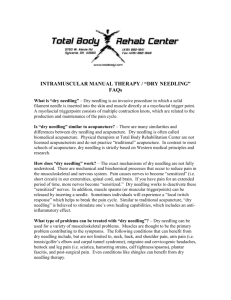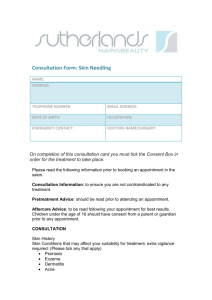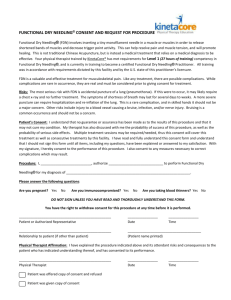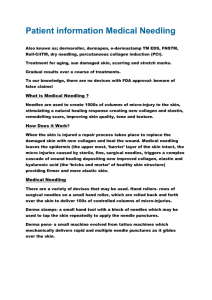The evolution of Integrated Dryneedling
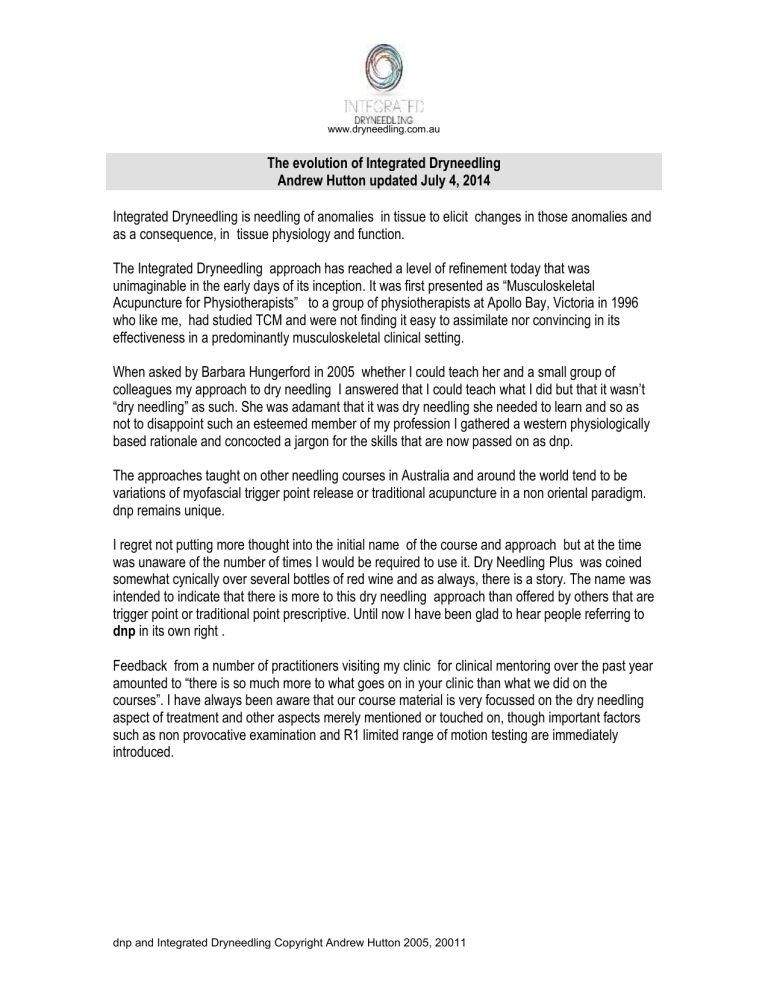
www.dryneedling.com.au
The evolution of Integrated Dryneedling
Andrew Hutton updated July 4, 2014
Integrated Dryneedling is needling of anomalies in tissue to elicit changes in those anomalies and as a consequence, in tissue physiology and function.
The Integrated Dryneedling approach has reached a level of refinement today that was unimaginable in the early days of its inception. It was first presented as “Musculoskeletal
Acupuncture for Physiotherapists” to a group of physiotherapists at Apollo Bay, Victoria in 1996 who like me, had studied TCM and were not finding it easy to assimilate nor convincing in its effectiveness in a predominantly musculoskeletal clinical setting.
When asked by Barbara Hungerford in 2005 whether I could teach her and a small group of colleagues my approach to dry needling I answered that I could teach what I did but that it wasn’t
“dry needling” as such. She was adamant that it was dry needling she needed to learn and so as not to disappoint such an esteemed member of my profession I gathered a western physiologically based rationale and concocted a jargon for the skills that are now passed on as dnp.
The approaches taught on other needling courses in Australia and around the world tend to be variations of myofascial trigger point release or traditional acupuncture in a non oriental paradigm. dnp remains unique.
I regret not putting more thought into the initial name of the course and approach but at the time was unaware of the number of times I would be required to use it. Dry Needling Plus was coined somewhat cynically over several bottles of red wine and as always, there is a story. The name was intended to indicate that there is more to this dry needling approach than offered by others that are trigger point or traditional point prescriptive. Until now I have been glad to hear people referring to
dnp in its own right .
Feedback from a number of practitioners visiting my clinic for clinical mentoring over the past year amounted to “there is so much more to what goes on in your clinic than what we did on the courses”. I have always been aware that our course material is very focussed on the dry needling aspect of treatment and other aspects merely mentioned or touched on, though important factors such as non provocative examination and R1 limited range of motion testing are immediately introduced. dnp and Integrated Dryneedling Copyright Andrew Hutton 2005, 20011
www.dryneedling.com.au
To create an opportunity for this particular dry needling approach to be studied within in the wider clinical context other than via clincal mentoring, I have renamed the course and dry needling approach Integrated Dryneedling, renamed my clinic, Integrated Physiotherapy and delveoped an outline for the IDN 3 course. IDN 3 presents dry needling as a tool within the the framework of other skills such as video and movement analysis, manual therapy, taping and retraining techniques as a powerful means to address movement dysfunction and address mechanical pain. I maintian that whilst many practitioers and patients alike focus on what the needles do it is what we are able to do do with the needles that has the greates bearing on our outcomes
“Necessity is the mother of invention” (William Horman 1519)
After studying traditional acupuncture via the APA Traditional Acupuncture Training Programme I found that the traditional approach to musculoskeletal acupuncture failed, in most cases, to produce changes in the functional objective measures (passive range, motor recruitment patterns, joint alignment and approximation, tissue irritability and proprioceptive changes) that I, as a physiotherapist, aimed to achieve in my treatments. It was some years later that I came to appreciate the effects on the body’s immune response, tissue and brain chemistry and inflammatory profile that may be accessed via a traditional acupuncture approach.
With the benefit of hindsight it seems likely that the small numbers of needles used in traditional acupuncture and western dry needling, combined with the relatively deep needling and intense needle manipulation utilised, resulted in unchanged if not reduced range of motion and reduced passive range of neurodynamic testing immediately following treatment. This was possibly due to the trauma induced in the target tissue by the techniques. That is not to say that patients may not have experienced latent subjective changes in pain levels and improved function but that immediate post treatment testing tended to show a reduction in objective measures.
Furthermore there were other characteristics of established needling approaches recognised in the literature, to overcome:
40% of people are considered non responders (Baldry, Gunn, Travell)
1/3 patients feel hot, sweaty, treatment should be discontinued (Huegenin 2003)
My initial aims were to explore different ways to use needles to achieve at least the immediate movement changes that could be achieved using the considerable range of manual techniques I had access to at the time and to address some of the less desirable aspects of other approaches.
The merits of superficial needling techniques had been explored by Baldry (1993) and possible dnp and Integrated Dryneedling Copyright Andrew Hutton 2005, 20011
www.dryneedling.com.au reasons for their effectiveness explained by Bowsher (1990) but the reassessment following needling had not been explored beyond subjective pain changes and tenderness on palpation of the needled site.
At around this time some colleagues introduced me to the lighter and more extensive needling techniques used in a traditional acupuncture approach known as Japanese Meridian Therapy. As so many other practitioners with a background in TCM and western trigger point needling have experienced, I found the techniques of this approach so light I could hardly believe they could be effective. These techniques were immediately of interest to me as they did not stimulate the undesirable systemic or tissue effects of other approaches. Whilst by no means practiced in their
“pure” form in dnp, these meridian therapy needling techniques were the inspiration and building blocks for the dnp needling techniques.
At the time,unskilled in the traditional assessment techniques used in this approach, I decided to use the assessment techniques I was familiar with:
Movement observation
Joint range of motion testing
Neurodynamic testing
Tissue palpation
Dynamic performance testing
Despite my very low skill level at the time, with the lighter needling technique the changes were not only encouraging but awe-inspiring and quickly the changes being elicited not only equaled, but in many situations surpassed what I had known to be possible with manual therapy. There was no need to have faith in the technique; Re-testing immediately after needling indicates clearly whether or not the technique has been effective.
One of the encouraging aspects of the dnp approach is that even when you are inexperienced and relatively unskilled you will see good results. These will only improve as you practice and achieve higher levels of needling skill and tissue sensitivity.
IDN has developed out of practice and not from science.
There is much in the scientific evidence base that goes some way to explaining some but not all of the changes seen as the result of dnp technique. The effects observed are well defined, and repeatable however the scientific data is relatively young and slow moving and is dealing with the effects of a single needle insertion and some of the more rudimentary effects of needling. It will be some time yet before everything we see in the practice of has a concrete explanation.
The following comments following assessment of the dnp training programme by the NZ college of
Physiotherapy in 2009 seem pertinent:
“there is no current research on this particular style of needling but in comparison to other styles of needling there are extensive references highlighting the clinical significance of dnp” dnp and Integrated Dryneedling Copyright Andrew Hutton 2005, 20011
www.dryneedling.com.au
“dnp is a paradigm soundly based on changes in function following musculoskeletal screening tests. This paradigm is yet to undergo research and may be compared to other treatment approaches in their infancy eg. Mulligan Techniques”.
IDN is an indirect treatment approach
A defining feature of the IDN approach is that it is an indirect approach to treating pain. Many treatment approaches, including other needling approaches, tend to focus effort on the site of pain or the area of pain referral. The dnp approach is different.
Needling aside, my general approach to treatment is to attempt to work out what aspects of a body’s mechanics or physiology have overloaded a particular site causing the development of:
pain sensitivity
inflammatory reaction
joints to exhibit “stiff” behaviour
muscles to exhibit “tight” behaviour
Stiff and tight behaviors are referred to as these characteristics of tissue are often attributed to structural or deeply seated neurological phenomena by manual therapists. Practitioners using dnp will observe rapid and, on occasion instant, change in these characteristics which requires another explaination.
Treatment effort, including needling techniques is then applied with the aim of improving:
Movement range and quality
Tissue irritability on palpation and neurodynamic testing
If successfully unloaded, changes at the site of inflammation and pain sensitivity will occur. Some of these changes will be immediate. Many will be latent. The therapist’s ability to confidently determine the success or failure of an intervention is determined immediately following treatment based on retesting, rather than on subjective outcomes reported by the patient. As other needling approaches tend not to immediately positively influence range of motion and movement quality they lack the immediate feedback regarding treatment outcome available to practitioners of dnp.
Assumptions underlying the IDN paradigm
Pain is a centrally modulated experience due to the brains perceived threat of tissue trauma, overload or other physiological changes in the periphery
Pain or inflammation resulting from altered tissue function of mechanical origin will cause dnp and Integrated Dryneedling Copyright Andrew Hutton 2005, 20011
www.dryneedling.com.au movement restriction and/or palpable changes somewhere
In the case of non traumatic onset pain these changes, in many cases, are not found at the site of the pain being reported by the subject. Treatment of these changes physiologically/mechanically unloads the site promoting modulation of the inflammatory response. Subjectively reported pain is often at the site of the inflammation response resulting from overload due to movement restriction altered tissue physiology elsewhere
Pain or inflammation resulting from direct trauma will cause movement restriction and/or palpable changes. Some of these may be some distance form the site f the injury but can be treated to enhance healing
Achieving assessable changes in range of motion and palpable changes in the tissue are indicative of improved tissue physiology/function and are likely to result perceived threat reduction and thus in the centrally driven pain response
Autonomic nervous system balance and function is reflected in palpable and observable phenomena such as areas of: o hot/cold o moisture/dryness o neurogenically driven tissue congestion or oedema o tissue reactivity/sensitivity o erythema or blanching
Changes in these phenomena following needling indicate alteration in peripheral and segmental nervous system function
IDN assessment
Non provocative examination
The dnp assessment does not rely on the provocation of the subjects reported pain in order to proceed with treatment. Although provocation of the reported pain on examination is fundamental in the training of many manual therapists it is rarely warranted. As a patient seeking treatment for a particular pain, the last thing I want to experience is that pain which freshens up the sensitivity of my tissues, nervous system and brain. As therapists commencing a treatment session with pain provocation we are already behind the starting line playing catch up. The patient has already formed brain level associations with you, the therapist, your clinic environment and the pain sensation they have been experienced.
Most manual therapy professions claim to treat the underlying causes of pain, as the slogan “move well, stay well” suggests. As movement experts we should be able to assess and treat the movement dysfunction that results in a pain problem and not have to rely on the provoking the pain the patient is able to locate and describe to us.
Movement Observation dnp and Integrated Dryneedling Copyright Andrew Hutton 2005, 20011
www.dryneedling.com.au
Active movements and techniques are observed and compensatory or trick movements noted.
With dnp we are aiming to improve the range of “trick free” movement. Areas that should move but do not are noted for more specific examination.
Dynamic movement testing
Performance of specific test type tasks such as single leg stance or hop is observed. Whilst complex these tests incorporate assessment of muscle recruitment patterns, segmental alignment, proprioception, core control.
Range of motion testing
The range of movement testing used in dnp involves the measurement of trick or compensation free range to R1 or the point at which the first increase in passive resistance occurs. The range of motion to the point of R1 is the range that a body will access during normal movement. It will rarely if ever provoke pain. If we successfully alter the range at which R1 is reached we will often positively influence our post treatment observations of active movements and dynamic test performance.
Neurodynamic testing
Since being introduced by David Butler as a test of neural mobility, neurodynamic testing has for many of us, become part of our examination portfolio. When done on a subject with significant overpressure these tests often provoke significant discomfort. No-one believes for a minute that these tests are isolating a single neural structure and revealing its mobility. To do so would be naïve. We use the tests in dnp to a point of R1 and interpret them as an indicator of net irritability of all structures along the pathway being assessed. Neurodynamic testing is an indirect assessment of tissue irritability.
Tissue palpation
Palpation is a direct assessment of tissue irritability. It can be much richer experience than just poking around looking for sore spots that make a patient jump.
Skilled palpation and interpretation of our findings give us:
• Extent to which the peripheral nervous system is affected by the current overload situation
• Real time insight into the state of autonomic nervous system function
• How long and how intense the loading of the tissue has been
Excellent palpation skills must be developed in order to effectively use dnp technique. This can be confronting for even very experienced practitioners as refined palpation does not tend to be emphasised in our training courses indeed many of us seem to rely more on the expression on a patients faces when we poke their tissue than the information our hands are conveying to us.
Interpreting assessment findings
When determining the significance of our assessment findings we can mostly focus on big differences in joint range. If you have to squint and think too much they are probably not significant. dnp and Integrated Dryneedling Copyright Andrew Hutton 2005, 20011
www.dryneedling.com.au
If pain sensitivity or inflammation is mechanical in origin there will be movement restriction and/ asymmetry. It may be some distance from the site of pain. If neither exists consider non mechanical causes.
IDN Quadrants
Whilst some practitioners are familiar with indirectly addressing pain problems, many are not.
Needles are tools. In order for them to be effective they need to be applied within an effective context. dnp techniques are used extensively to alter tissue physiology and movement patterns and thus indirectly affect pain sensitive and inflamed structures. Dividing the body into quadrants and prioritising which need to be addressed to chronicity and complexity of the presenting problem gives the practitioner who is inexperienced in indirect technique a starting point.
Supplementary techniques
People often ask in courses whether needling is the only thing I do in a treatment. I am a sports physiotherapist and have spent many hours, poolside, trackside and on sidelines assessing movement and injuries, screening squads and coaching technique changes for a wide range of sports and activities. I spend many hours each week developing cues for postural improvement and helping patients learn and development more efficient movement strategies in order to treat and prevent injuries.
The IDN assessment gives us a snapshot of the body’s hardware and software.
Our dnp techniques allow us to quickly alter the software, quickly alter the behavior of the hardware and to structurally alter the hardware over time. If we apply dnp techniques to influence factors identified in our assessment that have occurred due to loading over time, everything else we can do to change the load will enhance the effectiveness of out intervention.
This is the role of:
Exercise therapy
Postural improvement
Technique and movement coaching
Direct load alteration: orthotics, taping techniques
Conclusion
Over time IDN has developed its own unique character amongst dry needling approaches. It has grown from seeds in many sources and been shaped by the needs of manual therapists working in a mechanically based musculoskeletal setting. It has always been a pleasure to demonstrate the way I integrate needling into my own clinical practice to those who are interested. I am intrigued on a daily basis with the effectiveness of this dry needling approach and warmed by the enthusiasm with which I see others embrace the technique.
Andrew Hutton
Developer and Presenter
Integrated Dryneedling dnp and Integrated Dryneedling Copyright Andrew Hutton 2005, 20011

